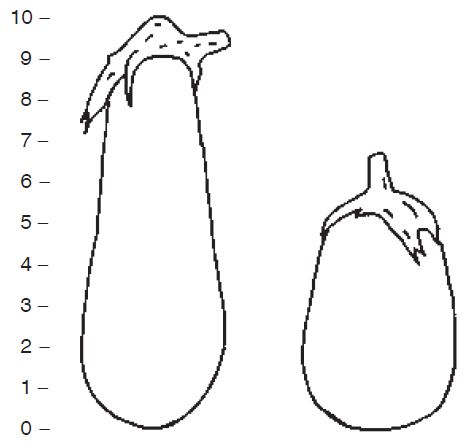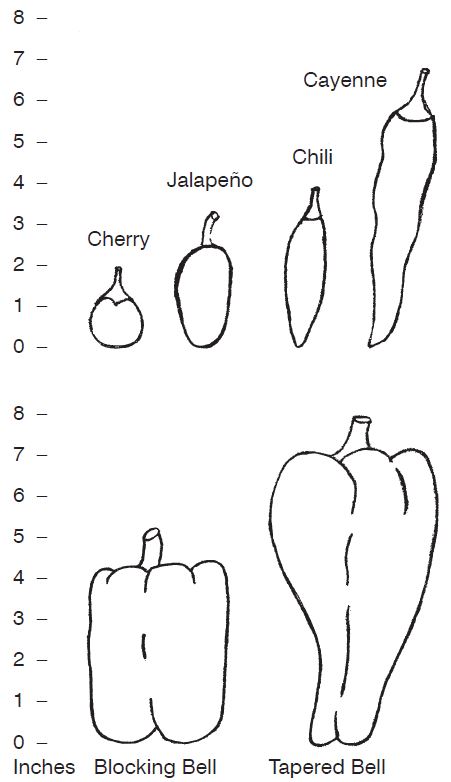by J.E. Ells* (11/20)
Revised by J. Murgel**
Quick Facts…
- Peppers and eggplant are members of the Solanaceae family and have similar growing requirements.
- Both peppers and eggplant are best transplanted to perform acceptably in Colorado.
- Neither plant is tolerant of early- or late-season frost.
- Peppers and eggplants should be monitored for early evidence of pest damage during the season.
- Fruit should be harvested with pruning shears to avoid damaging the plant.
Peppers (Capsicum annum) and eggplant (Solanum melongena) may be started eight weeks before they are planted into the garden. Along the Front Range, both can be sown in April for transplanting into the field on June 1.
Plants can be grown by sowing seeds in a prepared potting soil 1/2 inch deep at 80 degrees F until seedlings emerge.
As soon as seedlings begin to crowd, transplant the plants into pots or cell packs and grow at 70 degrees by day and 60 degrees at night. Suspend fluorescent lights 8 inches above the plants as soon as they emerge to provide 13 hours of light each day. Include a single incandescent bulb to expand the light spectrum. LED grow-lights are energy efficient and are often designed to provide light in the spectrum ideal for plant growth.
A small greenhouse with automated heat can produce excellent transplants. If you have problems providing the required light and temperatures, purchase good plants prior to transplanting into the garden. The disadvantage of purchased plants is that variety selection is limited.
Because peppers and eggplants produce large fruit on relatively small plants they must have good growing conditions to produce abundantly. Make sure they receive full sunlight and are planted in the best part of the garden.
If you do a soil test, make sure you follow its recommendation. A good baseline fertilizer rate is 10 cubic feet of organic matter, 1 pound of nitrogen per 1,000 square feet of garden. Work soil amendments and/or fertilizer into the soil prior to setting out the transplants.
Cover the soil with black plastic mulch to suppress weeds, keep fruit off the ground and reduce surface evaporation, irrigation requirement and nutrient leaching. Hot caps or cloches can protect the transplants from wind and frost and advance the date of transplanting. Normally, hot caps are anchored in the soil, but you also can tape them to plastic mulch.
Arrange the plants 1 foot apart in the row, with rows 3 feet apart. This allows 3 square feet per plant.
Pests
You may encounter flea beetles soon after transplanting. If there are more than four per plant, spray with an insecticide registered for flea beetle control. A detailed list can be found at www.ipm.ucdavis.edu/PMG/r604300611.html. To deter cutworms, you may want to place cylindrical paper collars around the stems of plants.
Phytophthora is the principal disease of peppers. It is soil-borne and especially severe where drainage is poor. If drainage is a problem, plant peppers on ridges so they don’t stand in water. Eggplants may contract Verticilium wilt that gradually will kill the plants. Planting on uninfected ground is the only practical means of control for soil-borne pathogens.
Blossoms set fruit best between 70 and 90 degrees, when there is sufficient soil moisture and the bees are active. Pollen production is curtailed when the night temperatures fall below 55 degrees, resulting in poor fruit set.

Varieties
Eggplant fruit comes in a variety of shapes and colors that have little to do with the flavor or quality of the fruit. Colors range from black to pink to white, and shapes range from elongated sausages to eggs.
Eggplants grow well in Colorado. Check your favorite seed catalog for interesting and novel varieties. ‘Easter Egg’ produces a white egg-shaped fruit, ‘Black Beauty’ produces the traditional fruit, and ‘Oriental Express’ produces an elongated sausage-shaped fruit.

Peppers may be classified as sweet or hot, or by color. Most peppers are either green or yellow when immature. When they reach their maximum size, they usually turn red, similar to a tomato (to which they are related). Because the Colorado growing season is short, peppers generally are harvested before they turn red, although small peppers generally produce a fair percentage of red fruit. All peppers, including ornamental peppers, are edible. However, be careful tasting peppers of unknown hotness.
Harvesting
It’s best to harvest with hand pruners to avoid damaging the plant. You can enhance production by harvesting often. When fruit reaches acceptable size, remove it from the plant. If maximum-size fruit is desired, remove all but one or two fruits so they will receive all the plant’s resources.
Flavor or pungency is not influenced by maturity, so fruit may be harvested at any stage of maturity. If red peppers are desired, allow the earliest fruit to remain on the plant while harvesting subsequent fruit. Only the early-formed fruit of the large-fruited varieties has a chance to mature before frost.
| The following pepper types and varieties have done well along the Front Range. |
| Bells: Predi (large, elongated), Figaro (blocky), Jingle Bells (little), Islander (purple) |
| Bells, tapered: Ori (green), Fry King (yellow) |
| Cayenne: Super Cayenne |
| Cherry: Sweet Cherry, Hot Cherry |
| Chili: Super Chili (red), Hot Portugal (green), Paper Dragon (yellow) |
| Jalapeno: Jalapa |
| Ornamental: Candle Light |
*Former Colorado State University Extension vegetable crop specialist and associate professor, horticulture and landscape architecture. **J. Murgel, Extension Horticulture and Natural Resources Agent, Douglas County. 12/96. Revised 11/20.
Colorado State University, U.S. Department of Agriculture, and Colorado counties cooperating. Extension programs are available to all without discrimination. No endorsement of products mentioned is intended nor is criticism implied of products not mentioned.
Go to top of this page.





